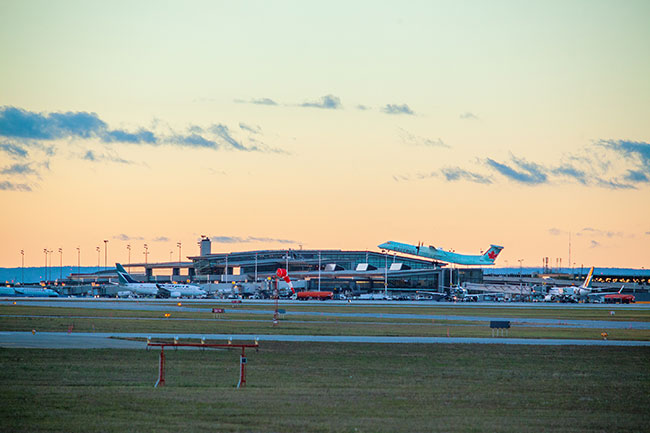
News
Airports
Air Traffic: Eyes on the sky
Inside the pioneering drone detection program at Ottawa International
July 5, 2021 By Krista Kealey
 Ottawa International Airport began working on its leading drone detection program back in 2018.
Photo: Ottawa International Airport
Ottawa International Airport began working on its leading drone detection program back in 2018.
Photo: Ottawa International Airport Early on the morning of March 15, 2021 a privately operated drone took an unauthorized 11-minute flight just north of the airfield at Ottawa International Airport (YOW). The same drone flew 24 flights during March, including flights close to the Civic Hospital Air Ambulance Helipad, the CHEO Helipad and Parliament Hill.
“We know what type of drone it was, its unique ID number, its flight time, flight path and its maximum altitude,” says Michael Beaudette, YOW’s Vice President of Security, Emergency Management and Customer Transportation. “It should not have been flying in any of those locations and, in doing so, was in violation of Transport Canada regulations.”
Beaudette is leading a pioneering drone detection pilot program at YOW in partnership with Indro Robotics, QinetiQ and NAV Canada. The results to date have been eye opening. “Drones are becoming almost ubiquitous, with exponential growth in sales to both hobbyists and commercial operators,” he says. “As an airport operator, we felt it was vitally important that we test systems to detect drones operating on flight paths, near the airport and in other restricted zones to help ensure the safety of air crews and passengers.”
The issue of drones operating near airports gained international attention in late 2018, when they were spotted flying near Gatwick Airport in the UK. The airport ended up suspending more than 1,000 flights, impacting 140,000 travellers. That incident led to the formation of a Blue Ribbon Task Force, commissioned by the Association for Unmanned Vehicle Systems International and Airports Council International, North America. YOW’s President and CEO Mark Laroche was a member of the Task Force along with representatives of the Federal Aviation Administration (FAA), Los Angeles World Airports and NAV Canada. The report was released in October 2019.
“The report provides direction to stakeholders on topics including unmanned aerial systems detection, mitigation/response measures, and guiding principles for response planning,” says Laroche. “At YOW, we had already started looking at drone detection as the first step to helping ensure safety.”
Transport Canada requires that anyone operating a drone that weighs over 250 grams must have a drone pilot certificate and only fly drones that are marked and registered. All drone operators must know and abide by Transport Canada regulations. “It’s forbidden to fly a drone within 5.6 kilometres of the centre of any airport in Canada,” notes Laroche. “Unfortunately, that hasn’t prevented it from happening. In March of 2021, our program detected and reported on 101 drone flights within that 5.6 kilometre radius. April’s numbers were even higher at 167. A number of these were flown during hours of darkness and some exceeding altitudes of 1,600 feet.”
There are two types of technologies being demonstrated in YOW’s drone detection pilot program: Radio frequency (RF) detection and micro Doppler radar.
RF drone detection is provided by Indro Robotics and Remote Sensing. Indro installed an RF receiver station on the roof of the passenger terminal building that can detect drones operating on 2.4 and 5.8 ghz within a 15-kilometre radius.
“Our system interrogates each device to gain more information to pin down GPS point X, Y and Z – Z being important as we want to know how high the device is flying,” explains Philip Reece, CEO of Indro Robotics. “We can also determine the make and size of the device, which helps determine what kind of threat it may pose. For example, a small, slow moving drone that’s far away is less of a threat than a large drone on an airport flight path.”
The system provides a user interface that features real-time and consolidated historical reports including drone ID numbers, in most cases.
“In March of this year, the Indro system detected 1,626 flights within the 15 kilometre zone, including 64 flights that occurred at night,” reports YOW’s Beaudette. “The totals were up significantly over January, as the weather got warmer and people decided to take their drones out for a fly.”
The second technology being demonstrated as part of the program is a micro Doppler radar solution called Obsidian from British firm QinetiQ. Obsidian uses millimetric wave radar – 9-12 ghz – to detect the movement of the small spinning propellers on a drone flying anywhere within 2 kilometres of the airport.
“The most serious threats to safety are not likely to be conventional drones that respond to electronic interrogationn, says QinetiQ’s Paul Romano. “Radar can detect and track drones that, for whatever reason, can’t be detected by RF or don’t want to be. Ultimately, it’s all about identifying all potential threats so that appropriate action can be taken to keep aircraft safe.” What actions should to take when a drone is detected flying where it shouldn’t is also part of the program.
“We’ve been conducting tabletop exercises with our partners at NAV Canada, Transport Canada, airlines, emergency services and law enforcement,” says Beaudette, describing the scope of the project. “Developing appropriate response protocols and responsibilities ultimately has to be part of the solution.”
Krista Kealey is Vice President of Communications and Public Affairs for the Ottawa International Airport Authority.